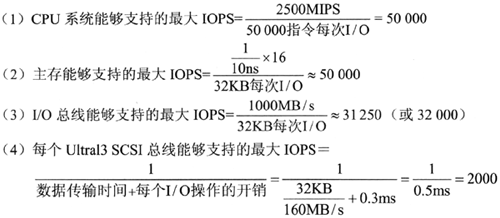阅读以下关于I/O系统处理能力评估的说明,在回答问题1至问题3。
拟建设的某事务处理系统数据交换非常频繁。经过初步分析,存储子系统的I/O性能决定了整个系统的响应时间。目前主流磁盘的容量为40GB和80GB两种规格。采用不同规格的磁盘,存储子系统的I/O性能会有很大的不同,同时也产生不一样的成本。评价使用小容量或大容量磁盘每秒每个I/O操作的成本,对于选择恰当的设计方案意义重大。
经过调研,该项目的系统分析师小刘得到了以下与存储子系统有关的部件的性能和成本说明:
(1)CPU系统,成本是20000元,处理能力是2500MIPS。
(2)主存的带宽是16字节,访问周期是10ns。
(3)1000MB/s的I/O总线,可连接20个Ultra3 SCSI总线和控制器。
(4)Ultral3 SCSI总线,成本是500元,传输速度是160MB/s,每条总线最多可以支持15个磁盘,执行一个磁盘I/O操作平均增加0.3ms的开销。
(5)每个磁盘I/O操作需要使用50000条CPU指令。
(6)安装磁盘的驱动器盒,成本是每个驱动器盒1500元。为磁盘提供电力和降温,每个驱动器盒配置一条SCSI连接线,可以安放80GB磁盘8个或者40GB的磁盘12个。
(7)无论是大容量磁盘还是小容量磁盘,成本都是10元/GB,转速都是15 000RPM (每分钟15 000转),平均寻道时间是5ms,传输速率是40MB/s。
为了进一步进行定量评估,小刘假设磁盘存储容量必须是1920GB(大、小两种规格的磁盘不能混用),每次I/O的平均数据量是32KB,每次磁盘I/O操作时间=平均寻道时间+平均旋转延迟+传输时间,所有磁盘负载都是均衡的,而且所有设备的能力都可以得到100%的发挥。
说明:用IOPS表示每秒执行的I/O数量。
| 【问题1】 (1)CPU系统能够支持的最大IOPS是多少 (2)主存能够支持的最大IOPS是多少 (3)I/O总线能够支持的最大IOPS是多少 (4)每个Ultra3 SCSI总线能够支持的最大IOPS是多少 |
参考答案:
解析:[解答要点]
 试题二
试题二
[分析]: 计算机I/O系统设计就是找出一种设计方案,满足成本、可靠性和设备多样性等目标,同时避免造成I/O性能的瓶颈。这就需要在内存和I/O设备间进行平衡,因为性能 (以及由此产生的有效性价比)与I/O链中性能最差的连接有关。 在设计I/O系统时,需要根据不同的I/O连接模式和每种I/O设备的不同数量分析系统的性能、成本、能力和可用性。性价比目标会影响I/O模式的选择和物理设计。根据不同应用,性能可以用每秒传输多少MB或完成多少次I/O操作来表示。限制高性能的因素有I/O设备的速度、数量,以及主存和CPU的速度,影响低成本的因素主要是I/O设备本身和到CPU的连接费用。 本题主要是计算题,需要对计算机系统主要部件的参数以及相互关系比较熟悉。[问题1] CPU的I/O性能是由CPU的速度和执行一次磁盘I/O操作所需的指令数决定的。
 主存系统的最大性能是由存储周期时间、内存带宽和每次I/O传输数据量决定的。
主存系统的最大性能是由存储周期时间、内存带宽和每次I/O传输数据量决定的。
 I/O总线的最大性能受限于总线带宽和每次I/O传输数据量。
I/O总线的最大性能受限于总线带宽和每次I/O传输数据量。
 Ultra3 SCSI总线性能受限于SCSI控制器的性能,通过SCSI总线传输32KB数据需要的时间=,加上0.3ms的SCSI控制器代价,每次I/O操作需要0.5ms,则每个Ultra3 SCSI总线能够支持的最大IOPS=
Ultra3 SCSI总线性能受限于SCSI控制器的性能,通过SCSI总线传输32KB数据需要的时间=,加上0.3ms的SCSI控制器代价,每次I/O操作需要0.5ms,则每个Ultra3 SCSI总线能够支持的最大IOPS=
 。
。

